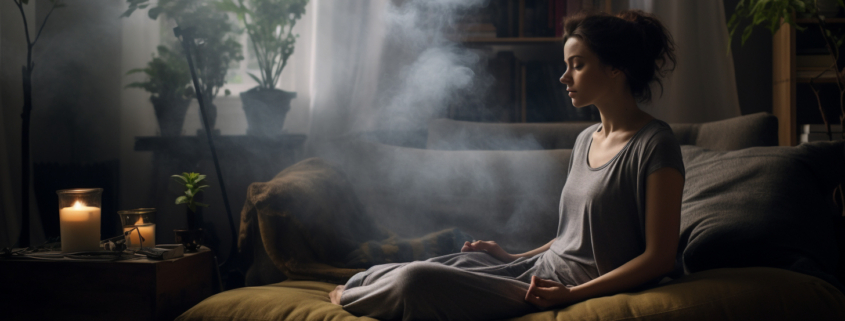Find Your Footing: 13 Grounding Techniques for Anxiety
Feelings of anxiety can get the best of us from time to time. If you have an anxiety disorder, ADHD, or suffer from panic attacks, it’s important to seek medical advice from a mental health professional. That said, you also have to be able to manage your mental health in daily life by developing coping strategies that can be used anywhere and anytime.
Distressing thoughts and flashbacks can make it hard to know what to do – but, these simple grounding techniques for anxiety can help you return to the present moment.
Symptoms of Anxiety:
-
- Increasing negative thoughts, anxious thoughts, or distressing thoughts
- Muscle tension
- Elevated heart rate
- Intrusive thoughts or flashbacks
- Feelings of dissociation
- Rapid breathing
- Sweating and trembling
- Irritability or restlessness
- Inability to concentrate
When To Use Grounding Techniques
Practicing grounding techniques can increase your sense of well-being, even if you aren’t struggling with anxious thoughts or a panic disorder. Regularly practicing coping strategies like these help you when you need them. Use these top grounding techniques whenever your nervous system needs a boost.
Anxiety can take hold anywhere, at any time. That’s why it’s important to be prepared. The following techniques can be used on the go whenever you find yourself struggling with anxious thoughts.
Breathing Exercises
Deep breathing is a great way to regulate the nervous system and ground yourself in the present moment. Focusing your breathing helps you slow down and regulate your emotions before they become too large to handle.
A few different breathing patterns are especially effective for fighting distressing thoughts and panic attacks. Across all techniques, it’s important to keep count of your breath and to focus on physical sensations to clear your head.
4-7-8 Breathing Technique
-
-
- Breathe in through your nose for four seconds
- Hold your breath for seven seconds
- Breathe out through your mouth for eight seconds
-
When you first start practicing this technique, you may only want to repeat the breathing pattern four times to avoid feeling lightheaded.
While this technique is completely safe, some people get dizzy at first. It’s best to practice this while sitting or lying down.
Box Breathing Techniques
Box breathing is similar to the 4-7-8 breathing technique. Practice this technique by counting your breath as you inhale, hold, and exhale. This is commonly done in intervals of four seconds, but some versions use three- or five-second intervals.
How to Use Box Breath:
-
-
-
- Breath in for four seconds through your nose
- Hold your breath for four seconds
- Exhale through your mouth for four seconds
- Wait for four seconds
- Start again by breathing in for four seconds
-
-
Practice the technique for four minutes or until you feel calmer.
Alternate Nostril Breathing Technique
-
-
- Pinch your right nostril closed and inhale for a few seconds
- Release your nostril and exhale
- Breathe with both nostrils and pinch both closed to hold your breath
- Unblock your right nostril and exhale
- Pause and then switch nostrils, repeating the process with your left nostril
-
Physical Grounding Techniques
Physical grounding techniques can help you feel rooted in the present moment and distract you from distressing thoughts. Often, they help you activate your senses and put you in touch with your environment.
Body Scan
A body scan is a meditative practice where you practice deep breathing while focusing on how various body parts feel. It’s best to begin the practice by sitting down or lying with your eyes closed.
Starting at the crown of your head, you mentally scan downward, noticing how your body feels as you do. This isn’t about changing anything – just noticing. Once you have scanned down to your toes, take a few moments to focus on the feeling of your breath, combining it with one of the breathing exercises above.
This helps you acknowledge your feelings and work with them calmly while practicing self-compassion.
To try progressive muscle relaxation while you scan your body, focus on relaxing each of your body parts as you go by tensing and then relaxing. As you get good at the practice, you won’t need to do the tension part of the exercise; you’ll just be able to relax.
Movement
Exercise isn’t just helpful to your physical well-being; it’s also a great self-care habit to develop for your mental health.
While you may not be able to drop everything and get a workout in every time you feel anxious, a simple walk can relieve stress and distract you from your negative thoughts. Movement helps release endorphins that lower your stress and regulate your nervous system.
Bonus points: Walk outside! Being in nature and breathing in fresh air can also help calm your nervous system.
Focus On Flavors or Sensations
Slowly eating or drinking something flavorful and focusing on the taste can help draw your attention away from distressing thoughts. Drinking cold water or holding on to an ice cube and focusing on the feeling of it in your hands can also help ground you in the present moment.
Smell Something
You can reap even more benefits from deep breathing exercises by focusing on a smell. Find something with a strong, pleasant, and soothing aroma, and breathe in deeply.
Use a Grounding Object
You can select a small item of your own and use it as a “safety” object to ground yourself. This could be a coin, a die, a rock, or a gemstone – anything within your reach. When you’re feeling anxious, hold or rub the item and focus on the sensation of it in your hand.
You can also do this with objects like fidget spinners and spinning rings – these items are specifically designed to distract from anxious thoughts.
Mental Grounding Techniques
Mental grounding techniques can help you strengthen your mind and provide relief from panic attacks and negative thought patterns. Mental grounding techniques are a large part of cognitive behavioral therapy (CBT), which is one of many treatments used for anxiety and depression.
Mindfulness
Mindfulness means being fully aware and engaged in the present moment.
To practice mindfulness, pay attention to the world around you. Slow down, stop reacting, and notice things. This can be overwhelming at first – you may not know where to start – but, the more and more you do it, the easier it becomes. Simply pause, breathe, and look around. Let your attention rest on things outside of yourself.
Meditation
Meditation is another form of mindfulness, and there are many ways you can practice it. Examples include guided meditations on YouTube and podcasts that walk you through a session. Some guided meditations are under three minutes long!
The body scan described in the physical grounding section is a popular part of many meditations, as well as box breathing. The key to meditation is to let your attention rest on a particular focus – such as your breath or the way your body feels – and when a thought interrupts that focus, you direct your attention back gently.
Five-Sense Exercise
If you don’t feel quite up to the task of practicing mindfulness or meditation, that’s okay. You can work up to it in a more guided way using the five-sense exercise.
This technique helps you build your ability to be mindful by giving you a structure to slow down and notice things around you.
Five-Sense Exercise Steps:
-
-
-
- List five things you can see
- List four things you can feel
- List three things you can hear
- List two things you can smell
- List one thing you can taste
-
-
Do this slowly while breathing deeply. The key isn’t to judge your surroundings but to look at them objectively, get in touch with reality, and calm yourself down.
List Your Favorites
To help combat negative thoughts and calm yourself down, make a list of positive things. Pick a category – for example, your favorite TV shows or favorite songs – and list as many as you can, either on paper or in your head. This strategy draws your attention away from anxious thoughts and gives you something pleasant to think about.
Listen to Music
Speaking of favorite songs, music is a great way to ground yourself and distract intrusive thoughts. Music has many overall benefits to wellness but is especially effective at reducing stress.
Some music can trigger negative emotions, though, so find music that helps distract you from your distressing thoughts rather than amplify them. Start with music that matches your frame of mind, and then work toward something more soothing, like classical instrumentals.
Your Mental Health Is Manageable
Handling a panic attack alone can be scary, but practicing these grounding techniques for anxiety can help you gain control of your thoughts and find greater well-being.
You don’t always have to go through it alone; we’re here to help. Our staff can find the techniques that work best for you so you can face the world’s challenges with confidence. Reach out today and schedule your first visit.





